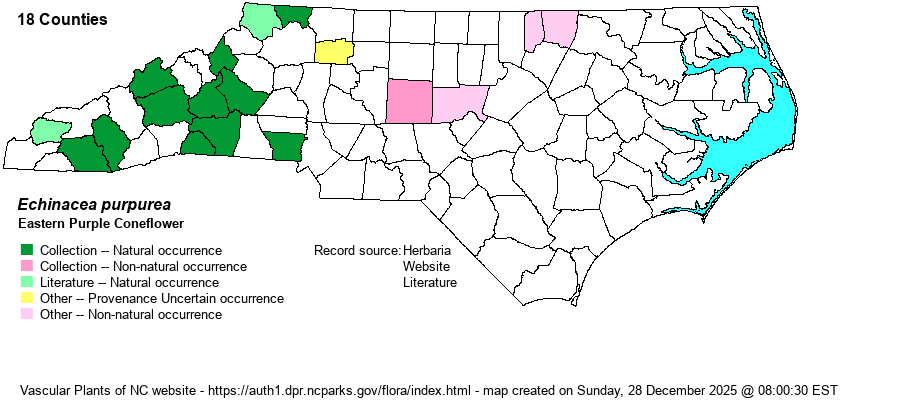| Author | (L.) Moench | |
| Distribution | Low Mountains and upper Piedmont, rarely to the central and eastern Piedmont. Records east of the foothills are undoubtedly adventive or escapes from cultivation. Mecklenburg County specimens are from cultivated plants. The Naturalist website has photo records for most counties in the Mountains and Piedmont, but the website editors are not using them to populate the map, as most are probably at planted locales.
OH, WI, and IA, south to northwestern FL and TX. Records to the east are suspect and need careful vetting. | |
| Abundance | Despite records from at least 17 counties, mostly as specimens, plants often grow singly or in very small numbers (usually single digits); the NCNHP's State Rank of S1 seems somewhat conservative, and the editors suggest S1S2. Note that it is possible that the entire species is adventive in NC, as the main range is clearly to our west. This is a Significantly Rare species. | |
| Habitat | Generally found along wooded borders, roadbanks, and other dry or mesic soils in light shade or in the open, not necessarily on high pH soil. "Dry old field" (Alleghany Co.), "Linville" (Avery Co.), "roadside near ultramafic area of South Mountains" (McDowell Co.), "roadside bank, edge of woods, South Mountains" (Rutherford Co.), "roadside up mountain, Crowder's Mountain SP" (Gaston Co.), "edge of meadow, Billy Cabin Mountain" (Macon Co.), "near Green River" (Polk Co.), "roadside" (Jackson Co.). Such habitats do not provide validation that the species is truly native in NC. | |
| Phenology | Flowering and fruiting May-October, but flowering mainly to August. All our purple coneflowers have been cultivated for medicinal purposes. | |
| Identification | Plants grow 1.5-3 feet tall, coarsely spreading-hairy. The leaves are lance-ovate to ovate, 4-7 inches long and coarsely toothed on the margins. The terminal heads have long, drooping, dark pink rays and a dull brownish yellow disk that becomes dome-shaped in age. The rough hairy stem and upper surface of the leaves separates it from E. laevigata. From E. pallida it differs in its wider leaves (3 cm or more wide vs. 2 cm or less wide). In addition, the rays are shorter than on the other species and, though deflexed, tend to look stiffer and not overly drooping/downcurved. | |
| Taxonomic Comments | None
| |
| Other Common Name(s) | None | |
| State Rank | S1 [S1S2] | |
| Global Rank | G5 | |
| State Status | SR-O | |
| US Status | | |
| USACE-agcp | | |
| USACE-emp | | |

